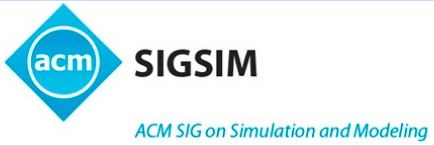Computational Power of Chemical Kinetics in Living Cells

Speaker: Gabriel Ciobanu , Romanian Academy, ICS, Iasi, Romania
Date and Time: 9am to 10am, December 2 (Tue)
Abstract
Membrane computing is a branch of natural computing working with parallel and nondeterministic computing models abstracting the living cell. We present mobile membranes in which the movement is provided by rules inspired by cells endocytosis and exocytosis. Their computational power is compared with the classical notion of Turing computability. These mobile membranes can algorithmically solve hard problems in polynomial time. Finally we compare them with other formalisms as mobile ambients and brane calculi.
Short bio: Gabriel Ciobanu is a senior researcher at the Romanian Academy of Sciences (Iasi branch), and a Professor at "A.I.Cuza" University of Iasi. His research interests include Distributed Systems and Concurrency, Natural Computation (Membrane Systems), and Theory of Programming (Semantics, Formal Methods, Algebraic Models). Prof. Ciobanu has served on the programme committees of numerous international conferences, and edited several books on these topics. He is the Editor-in-Chief of the Scientific Annals of Computer Science. For his work he received important Awards of the Romanian Academy of Sciences (in 2000, 2004 and 2013).
Molecular Communication: From Theory to Practice

Speaker: Andrew Eckford, York University, Canada
Date and Time: 1:30pm to 2:30pm, December 2 (Tue)
Abstract
How can we communicate using molecules? This question may unlock new applications in nanorobotics and medicine, but has only recently attracted attention from communication and information theorists. The answer to the question is surprisingly difficult: not only is the medium unfamiliar to communication engineers, but the mathematical details of the communication environment are complicated. In this talk, we present three examples to illustrate the current state of the field: for nanonetworking applications, we present the additive inverse Gaussian channel model; for biological applications, we discuss the information-theoretic capacity of intercellular signal transduction; and for experimental applications, we present a new low-cost, easy-to-use platform to evaluate macroscale molecular communication.
Short bio: Andrew Eckford is an Associate Professor in the Department of Electrical Engineering and Computer Science, at York University, Toronto, Canada. A graduate of the Royal Military College of Canada and the University of Toronto, his research interests include wireless networks, information theory, and molecular communications. He has co-authored a textbook and written numerous papers on molecular communication, work that has been covered by the Wall Street Journal and The Economist.
Agent-based Models and Ill-posed Problems

Speaker: Valeriy Perminov, BioTeckFarm, Ltd., Russia
Date and Time: 1:30pm to 2:30pm, December 1 (Mon)
Abstract
It is well known that evaluation of parameters for any mathematical model is always a difficult problem. This is especially true for agents-based models (ABMs) because an evaluation of agent’s parameters can be made only based on available information from a higher level of a complex system. Because of information at a higher level is an aggregation of data at the agents level such problems can be ill-posed ones. It means a problem under consideration can have a non-unique or unique but unstable solution. In the latter case numerical solution of the problem has to be based on very special algorithms. In this talk I am going to overview problems that arise for ABMs with different numbers of emergent patterns. In particular I am going to tell about new approach to creation of the ABM for an influenza epidemic spreading in cities. The proposed ABM can be used for past epidemics to estimate the efficiency or inefficiency of undertaken interventions, to propose new ones and to reveal its advantages, shortcomings and cost. This ABM is the first one that under some conditions can be used to model the possible dynamics of coming epidemics or pandemics.
Short bio: Dr. Valeriy D. Perminov was a senior researcher of Central Aerohydrodynamic Institute in Moscow for a long time. His research interests include rarefied gas dynamics, ill-posed problems, agent-based models and its application to infectious diseases spreading.
Socialized WBANs in Mobile Sensing Environment

Speaker: Honggang Wang, University of Massachusetts, Dartmouth, USA
Date and Time: 8am to 9am, December 2 (Tue)
Abstract
Short bio: Dr. Honggang Wang has worked for Bell Labs Lucent Technologies China from 2001 to 2004 as a Member of Technical Staff. He received his Ph.D. in Computer Engineering at University of Nebraska-Lincoln in 2009. He is an assistant professor at UMass Dartmouth and is an affiliated faculty member of Advanced Telecommunications Engineering Laboratory at University of Nebraska-Lincoln. He is also the faculty member of Biomedical Engineering and Biotechnology Ph.D. program (BMEBT) at UMass Dartmouth. His research interests include Wireless Health, Body Area Networks (BAN), Cyber Security, Mobile Multimedia and Cloud, Wireless Networks and Cyber-physical System, and BIG DATA in mHealth. He has published more than 100 papers in his research areas, including more than 30 publications in prestigious IEEE journals such as IEEE TWC, IEEE TM, IEEE TVT, IEEE JSAC, IEEE TITB, IEEE TIFS, IEEE TSG, IEEE CM, IEEE NM, IEEE WCM, IEEE TNSM, IEEE TETC, IEEE System Journal and Pattern Recognition. He also published papers in prestigious conferences such as INFOCOM, ICDCS, ICC, Globecom and ICME.
Collective Construction by Termites and Other Robots

Speaker: Justin Werfel, Harvard University, USA
Date and Time: 8:30am to 9:30am, December 1 (Mon)
Abstract
Termites build huge, complex structures through the collective actions of millions of independent agents. These natural systems inspire the research area of collective construction, whose goal is to develop autonomous multi-robot systems that build large-scale structures according to user specifications. I will discuss the design and realization of such a system, in which climbing robots flexibly build structures using specialized building blocks. Robots act independently under decentralized control, using local information, onboard sensing, and implicit coordination through manipulation of a shared environment. A user can specify a target structure using a high-level representation, and robots follow simple rules that guarantee the correct completion of that structure. I will also briefly discuss ongoing experimental studies of African termites, aimed at better understanding their individual behaviors and how these give rise to the structures they produce.







































